Swollen salumeria tits, prominent nipples, skin full of buttery health: these are some of the images that Arbasino, in Fratelli d’Italia, associates with the procubescent, seductive and buxom women who populate in large numbers the paintings of Guido Cagnacci, an extraordinary protagonist, dissipated and underestimated, duna of the most singular events of the seventeenth century, if not of the history of Italian art as a whole. Arbasino had in mind one of the Romagna painter’s late masterpieces, Death of Cleopatra, executed when the artist had already left Italy to end his days in Austria, and already mentioned in 1659 in the picture gallery of Archduke Leopold Wilhelm of Habsburg. It is one of the best-known images that sassociate to Cagnacci, along with the other didentical subject painting executed in the same damage torno, the Cleopatra now in the Pinacoteca di Brera, made with an essential chromatic range that leaves to a diffuse and limpid light the task of desalting the languid and soft body of the queen of Egypt who begins to lose her senses. It was the first time ever that a painter imagined dinterpreting Cleopatra’s death in these terms: not the moment when she is about to bring laspide to her breast for him to bite her (or the listante immediately following, with a few drops of blood beginning to ooze from her ivory skin), nor even the theatricalSeventeenth century, the one preserved in Genoa, at the Palazzo Rosso, with the curtains of the canopy that saprono, by way of dimprobabile curtain, to unveil leroine who has just performed the gesture and is there to spill onto the pillow, since her left arm will not be able to support her weight, and we must therefore imagine her sliding downward (although the solid evidence of thatarto makes it appear to us as sturdy as a column). None of this is the case: in Cagnacci’s painting, the heroic dimension of Cleopatra’s gesture is diminished to leave room instead for a real woman, caught in her epidermal tangibility, whom we almost cimagine touching and daccaressing so much is her carnality bursting forth, in one of the most physically powerful paintings of the entire century.
The solitary drama of the Milanese painting becomes choral in that of the Kunsthistorisches Museum in Vienna, but the level of reality remains entirely unchanged: the queen ofEgypt is seated on an imposing and anachronistic high chair (“from an already faux sixteenth-century notary abolishing seals,” limited to “studs over red leather freshly pulled by the upholsterer,” Arbasino had wittily noted), is already falling into the fatal slumber procured for her by theaspis still clinging to her arm in the guise of a necklace, while around her a handful of half-naked dancelles, one of whom pops out from behind the pew displaying a breast in perfect diagonal with Cleopatra’s breasts, rush in in confusion. The women wince at the sight of the serpent, sang, one of them already weeping and wiping her eyes with a handkerchief. But it will be agreed that what attracts us is not so much the rendering of the historical episode as the fragrant, palpitating and almost ostentatious nudity of the beautiful queen and her host of servants, in a variety of poses deliberately studied to restore to the eyes of the viewer a "galeries des femmes that seems to summarize the experience of an entire career in female nudity but also to compose a rebus of disparate allusions" (so Alessandro Brogi).
A jumble of feelings (fright, pain, anguish, attention) that unravels on a unique score built from the naked body. No other painter in the seventeenth century would have dared so much. Guido Cagnacci’s painting would have known various seasons, but the sensuality of the female body remained a constant that would accompany him seamlessly, from his youthful years to his most extreme phases. Those who have visited the seventeenth-century painting rooms of the Galleria Nazionale dArte Antica at Palazzo Barberini cannot have failed to notice the impressive Penitent Magdalene, which a Cagnacci of 25 or thereabouts had painted almost forty years before Death of Cleopatra. The dating to the mid-1920s, proposed by Gianni Papi and never questioned, brings us to a period in which there are no documentary records of Cagnacci’s activity, but these are the years following the artist’s well-documented stay in Rome: in the then capital of the Papal States, Guido, at the age of twenty, had taken a house in what is now Via del Babuino (Strada Paolina, it was called at the time), and was sharing it with another great of the time, Guercino (who was exactly ten years older than Guido), with the Cento painter Lorenzo Gennari, and with a certain Giovanni Battista Croce, about whom we know nothing, perhaps a servant. The Magdalene of Palazzo Barberini is an unmistakable product of that period: the uniform and contrasting backgrounds reveal Guercinesque debts, the blue tone of the sky and the way the drapery is treated are reverberations of Orazio Borgianni’s painting, the stark realism of the penitent saint cannot fail to evoke, given moreover its precocity, the painting that was being practiced in those years in Rome in the wake of the disruptive Caravaggesque lesson (and there is no reason not to think of a Cagnacci whom Rome admires, fervently appreciates and studies the paintings of Caravaggio and especially of his followers, beginning with Orazio Borgianni and Giovanni Francesco Guerrieri, given thosevident Caravaggism already attributed to him by Cesare Gnudi, among the first to initiate the twentieth-century rediscovery of Cagnacci). The result is one of the most provocative nudes in the history of art, with that full and true breast that almost acts as the fulcrum of the entire composition: its concreteness is even enhanced by the unnatural twisting of the neck that makes the face disappear backwards (we cannot grasp the details) and by the cascade of blond hair that almost frames the ivory of the skin. A nude so impudent that even critics have been surprised by this painting, finding no philosophical or religious reason to explain it: here, there is only a woman suffering the pains she is self-inflicting with the lash she holds in her right hand and meditating on the vanity of life, with the skull resting on her lap.
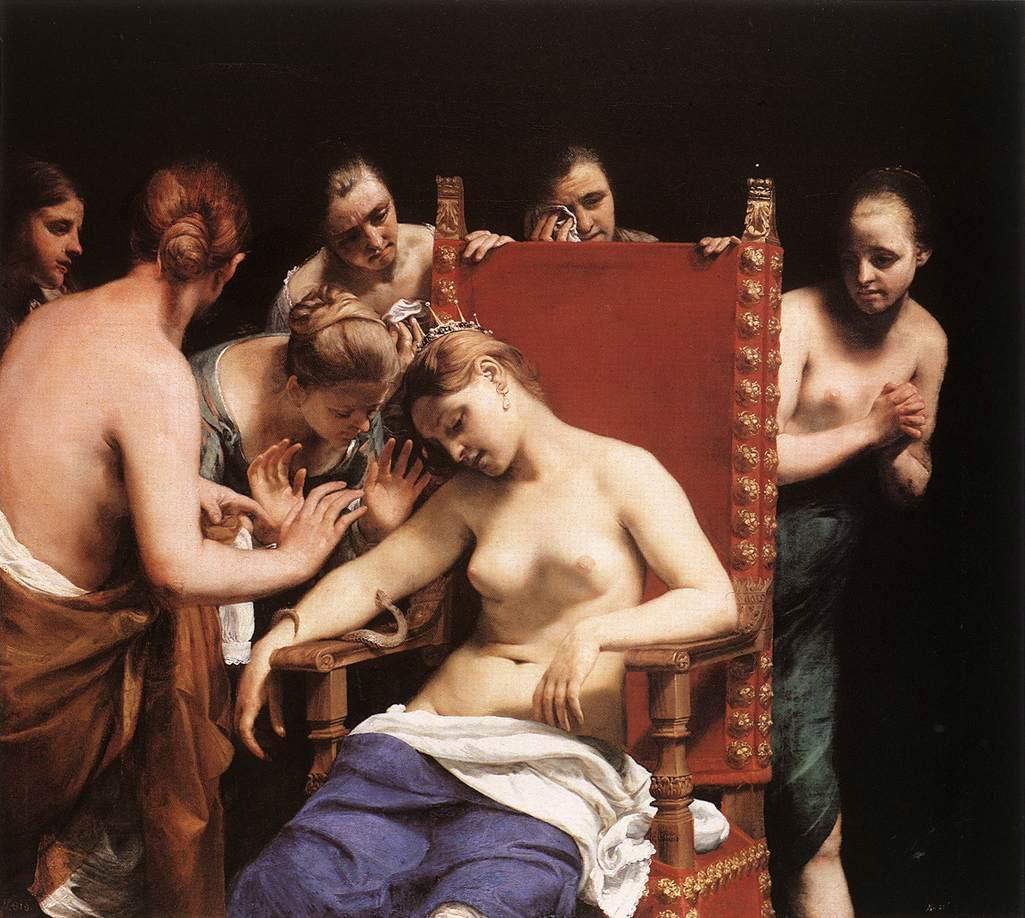
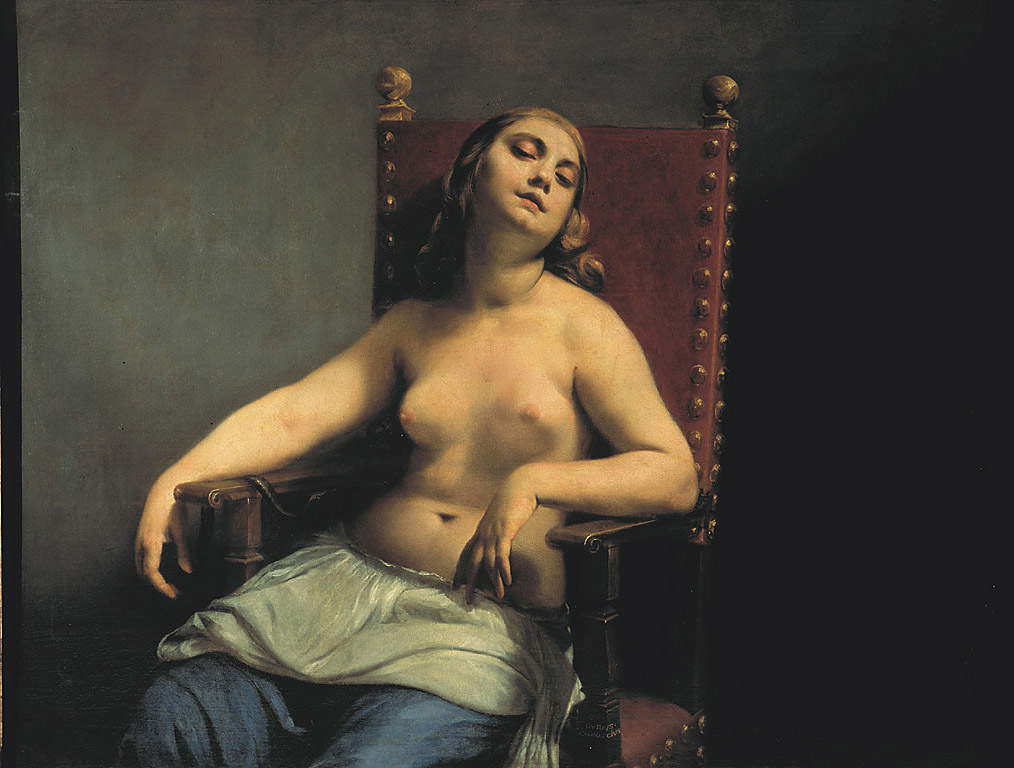
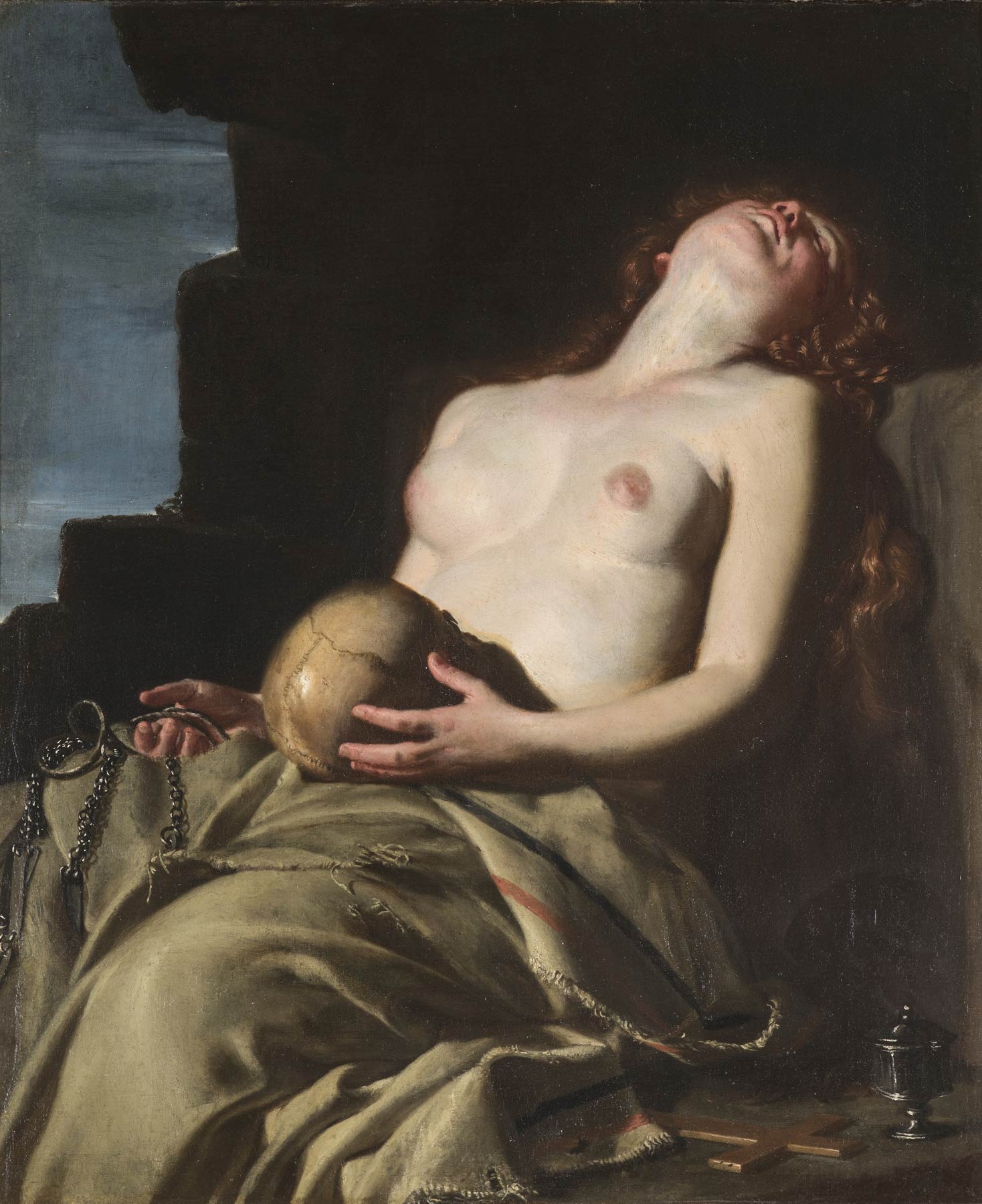
It might be easy to explain this continued insistence on the nude female body on the basis of Guido Cagnacci’s love for women, a love capable of fueling the myth of the painter surrounding himself with models who invariably became his mistresses, born on the basis of the rumors “that in these our quarters nevertheless pass on the vulgar mouths,” explained mid-eighteenth-century Rimini painter Giovanni Battista Costa, whose correspondence with Nicolò Gaburri and Giampietro Zanotti represents one of the main sources for drawing information about Cagnacci. But then Zanotti himself reported laneddoto of the young girl dressed as a man who would always accompany the painter in the days when he resided in Bologna, in the early 1640s, before his wandering existence took him to Forlì, always in the wake of the slanderers that would lead him to change residence several times, until he took shelter in Venice in 1649 (in the lagoon city he would take to using a new identity: Guido Ubaldo Canlassi da Bologna) and then moved permanently in 1660 to Vienna, where he would die three years later. And it may perhaps be said that this constant elopement was due to his love, reciprocated, for a woman, a Rimini noblewoman two years his senior, Countess Teodora Stivivi, with whom Guido, in 1628, had exchanged a promise of marriage: the two lovers were about to elope (their elopement was meant to convince her parents to grant their daughter’s hand in marriage to the alumile painter, who could not boast of a lineage comparable to that of his fiancée), but their dream was shattered by papal cops who arrested the girl before their purpose could be fulfilled. Delator was Matteo Cagnacci, Guido’s father, who knowing his son’s intentions resolved to denounce him. Theodora, because of the dishonor caused to the family, was segregated in a convent where she remained for two years, and came out only on a promise to marry a distant relative, of equal status, who would save the honor, and above all the conspicuous and greedy dowry, of the young woman. Guido, however, was banished from Rimini.
The scandal of Guido and Theodora’s negotio was such that it caused the painter (who for years would attempt to make his case in court, but failed to do so: indeed, his father eventually disinherited him and left all his property to the painter’s sisters, Virginia and Lucia) continual problems throughout his life, since the fame of his attempted amorous venture continued to follow him wherever he went, alienating the sympathies of his patrons, and since it is likely to imagine that he also received threats, since it would have been easy for the mentality of the time to portray Guido as an inveterate corrupter of youth. A bad reputation that would haunt him even after his death, causing him the damnatio memoriae that would expunge him, for a couple of centuries, from art history, until the complete rehabilitation that came in the mid-twentieth century. Other women would, however, have followed the artist at different times in his life: a document from 1636 attests that a certain Giovanna, daughter of a mason from Serravalle, donated all her possessions to the painter, although we have no idea why, perhaps to legitimize an irregular relationship. And again, one of his mistresses, Maddalena Fontanafredda, lived with him in Venice and allegedly accompanied him to Vienna.
Levidente Guido Cagnacci’s familiarity with the female gender may in part provide some empirical reason for his continuing interest in mulieval nudes. And travel, the basis for declining this interest according to new forms. Lincontro con Guido Reni in Bologna would have produced, among other works, the very dramatic Lucrezia already in the Ruffo di Calabria collection, datable to the second half of the 1930s, and which introduces a new classicist component to Cagnaccesque painting, without the painter renouncing his naturalistic substratum. The violent gesture of the Roman heroine who rips open her robe to stab her breasts, exposing the latter to the viewer, is amplified by the curtain that continues it, creating a diagonal that runs across the entire canvas and gives a highly theatrical sense to the entire painting. The fact that Guido Cagnacci was at that time in contact with Reni (this can be seen from the features of Lucrezia’s face, although deformed by the dira grimace in which leroina produces herself, and again from the coloring deglincarnati, the woman’s volumes, the delicate chromatic drafting, and the greater idealization) did not impede him from renouncing the realistic foundations of his painting in order to cloak his figures in the sensual physicality that distinguishes them. And this also happens on a sentimental level: if Guido Reni’s Lucrezie are always traversed by a motion of resignation and regret, Cagnacci’s, on the contrary, does not lose its strength, all rendered by the furious impetus of his gesture. Nor does it lose its sensuality.



In the same torno danni, the painter from Santarcangelo would accomplish what Daniele Benati, curator together with Antonio Paolucci of the largest exhibition ever dedicated to Guido Cagnacci, the monographic held in 2008 at the San Domenico Museums in Forlì, calls “an enormous leap,” the one that would lead him to paint Magdalene Taken to Heaven (known in two versions: one, older, preserved in Munich, and the other in Palazzo Pitti), and which is explained on the basis of the coeval research of Guido Reni, who at that time was moving, writes Benati, “toward solutions of extraordinary power and communicative force.” Mediating on the formal level is the young Simone Cantarini, who around 1640 or shortly before had fired an innovative St. James the Greater in Glory, with the saint standing on two somber clouds and escorted toward a swirling golden sky of cherubs by a pair of dangels who embrace the clouds and lift him to heavenly glory. For Francesco Arcangeli this was the “essay of the highest point of Reniism touched by Cantarini, perhaps around 40: a shiny, thin page of cold, golden clarity, with handsome angels cross-legged on the sky, in penumbra, and with the saint who, in comparison with Reni’s ideal fare, resembles a blond musketeer.” The reluctant and eccentric Pesaro artist had not wanted to depart from his master’s lesson, but at the same time he cultivated a desire to find his own way, made up of vigor and naturalism grafted onto the Reni score and here evident especially in the figures of the two angels and to some extent also in the face of the main protagonist. It is hard to imagine that Guido Cagnacci, in composing his superb Magdalene, did not look to the painting achievements of his younger colleague, and in particular to this masterpiece. The painting in the Alte Pinakothek in Munich and the Florentine one, with the latter slightly more recent than the German exemplar, which, being closer (especially chromatically) to Cantarini’s San Giacomo and being decidedly more crystalline than the Tuscan version (and thus ideally more contiguous to Guido Reni’s painting), should be considered the prototype, are among Guido Cagnacci’s happiest and most successful inventions. The aforementioned Costa, referring to the painting from Munich, seen in the home of the Angelelli family in Bologna, wrote that “Cagnacci, when he was not celebrated for many of his other remarkable works, would be so solely for this one, such is the beauty of this painting in many kinds of perfection; and with good reason many writers have made honorable mention of it.”
Others, on the contrary, would not have been so in agreement: the Magdalene also had noisy detractors. An Academician of the Crusca, Giovanni Masselli, wrote about the painting in 1838 and, while recognizing Cagnacci’s merit for having conducted the figures “with admirable impasto and with tints that very much resemble the real thing,” and for having given “beautiful relief to the parts with the very intense placement of a few lights on the more prominent parts , and with no less judicious distribution of the half-tones and shadows,” he reproached some “capricious liberties” to the Romagnolo, going so far as to say that “quell’angelo che sostiene la Maddalena non può essere lodato da veruno che ami nella pittura la convenienza e il decoro.” Certain critics did not forgive Guido the unusual audacity of his invention: the penitent saint, completely nude and with only her long blond hair covering her pearly skin (but note how the painter did not conceal Magdalene’s pink nipples from our view: the sapre hair right on her breasts), she is assumed into heaven with the help of an angel who supports her by holding her legs, and turning his gaze toward her terga, in a tangle of voluptuous, pungent-tasting flesh, devoid of any even approachable precedent. What makes this unparalleled essay in deroticism applied to a painting of a sacred subject truer are the position of the saint’s soft legs, the reddening on her cheeks and on the fingers and toes (an element, this, that recurs in many of Guido Cagnacci’s women), and her marked realism, which makes her appear to us to be a truer woman than those Guido had painted up to that time. It is necessary to note how hardly in Cagnacci sassista to a meeting (and at the same time to a clash) so obvious between carnal drives and spiritual tensions (“the body and the soul”: so Benati titled his essay in the catalog of the Forlì exhibition of 2008).
We return, at this point, to the fundamental question: what drive had led Guido Cagnacci to devise such earthly, such carnal, such sensual, such real figurations? Beyond his personal experience, mentioned above, the examination of his figurative sources partly helps to dispel some doubts: to the list of names that have been mentioned so far it is necessary to add at least two others, that of Orazio Gentileschi and especially that of the French artist Simon Vouet, another artist whom Guido had the opportunity to meet in Rome (probably also in person, as Mina Gregori has suggested). Vouet represents a privileged, though not unique, key to explaining Guido Cagnacci’s sensuality: the Parisian’s painting inaugurated a new type of muliebre, a self-conscious, feminine, daring, dominating woman, like the courtesan we see in the perturbing Temptation of St. Francis, one of the most singular masterpieces to be found in the churches of Rome (it can be admired in the Alaleoni chapel of San Lorenzo in Lucina).
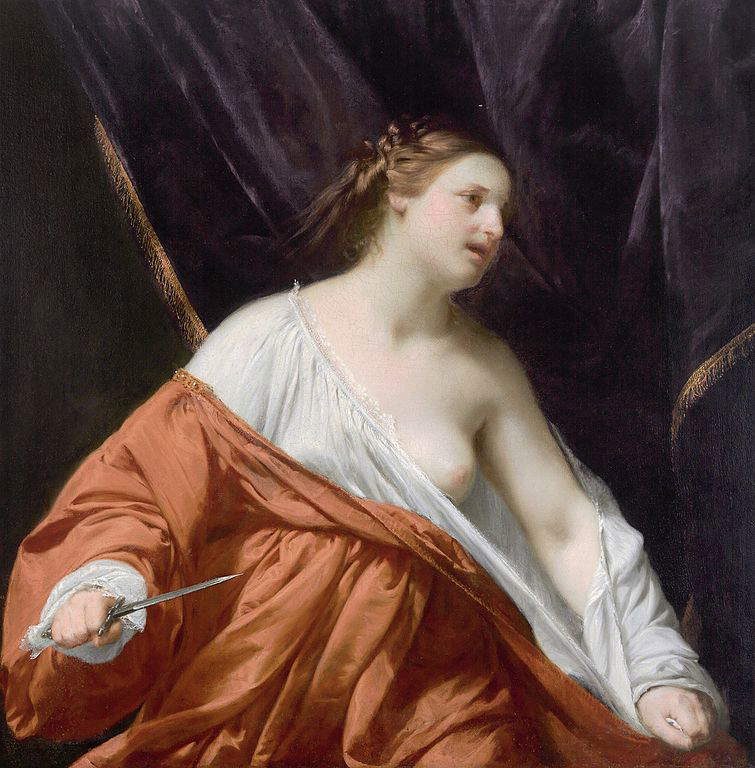
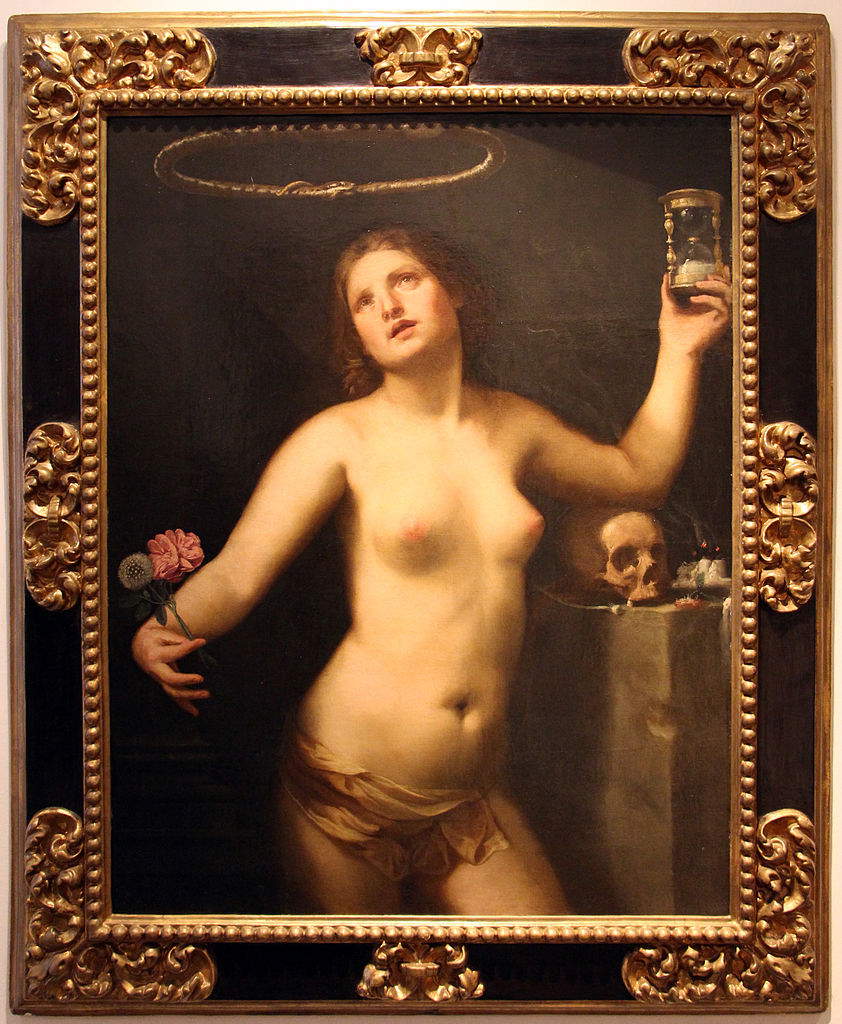

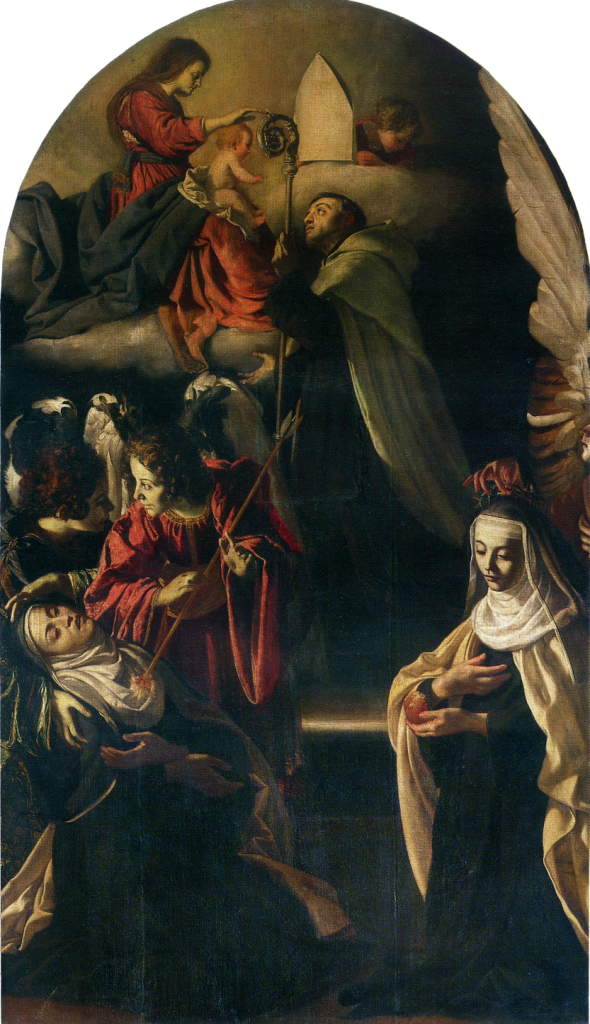
But even without reaching the levels of the provocative meretrici of the San Lorenzo in Lucina painting (a “seriously temptress,” Goffredo Silvestri had to write with acute irony), the same reasoning could be applied to many other women who abound in Vouet’s production and whom Cagnacci certainly had come to know. There is then to consider the centrality of the human body in seventeenth-century art, which became fundamental since the psychagogic function of religious art images in regard to the faithful required that the actions of the saints be captured in all their physical and bodily evidence. A centrality that Cagnacci perceives and filters according to his intimate sensibility: the painter, Paolucci has written, “is an erotic painter.” And he is erotic in the true and profound sense of the term, because, Paolucci asserts, “he senses and expresses with an intensity common to few others in the century the pulsion of theeros that beats, incessant and deep, in the blood of men and women,” heroes and heroines who “know and suffer the inescapable domination of sex that oppresses and consoles us all.” The genre of the nude, which through the study of ancient art had returned to contemporary art toward the end of the second decade of the seventeenth century, saw in Cagnacci the crudest and most resolute interpreter of the first half of the century. To find similarly exhibited nudity one must look to the Florentine Francesco Furini, but glintings are opposite: as earthy and carnal was the nude of the Romagnolo, as formal and classical was that of the Tuscan. It might then be interesting to examine his clientele as well, especially those of the Venetian period, when Guido Cagnacci was working in a free city with more relaxed customs than elsewhere, where he frequently had to find patrons eager to bring sensual female nudes cloaked in historical rhetoric into their homes, religious, mythological, or allegorical ( Allegories of Human Life are quite frequent in the Venetian years) in order to find a form of justification that would give full permissibility to subjects that, were it not for the narrative dimension that was part of the permissible types, would have entailed certain trouble for the owner of the painting.
But Guido Cagnacci knew how to dissimulate well and proved it throughout his life, often walking the edge of ambiguity, on the border between what chera tolerated and what chera instead condemned. It is a feeling one gets from looking at a masterpiece preserved in Rimini, in the church of St. John the Baptist, for which it was made by a Cagnacci at the time in his thirties and from where he never moved except for temporary exhibitions. The altarpiece, more than three meters high, depicts three Carmelite saints, Andrea Corsini, Teresa dÁvila and Maria Magdalena de Pazzi, at the feet of the Virgin and Child, who are on a cloud, defiladed on the left, as they address Andrea Corsini. In addition to being a work where the dissent between body and spirit touches supreme heights, it is the most accomplishedly Caravaggesque painting of the early part of Guido Cagnacci’s activity, formidable in its portrayal of three distinct moments d’incontro con la divinità by the three saints: Andrea Corsini’s vision is essayed by the suffering of Maria Magdalena de Pazzi, who receives the crown of thorns from an angel with very long wings, and the transverberation of Teresa dÁvila, struck by the fiery dart of the heavenly creature the painter places at her side. The figure of the Spanish mystic falling into a swoon is certainly the one that most attracts and impresses the viewer concerning her, given her almost orgasmic abandonment in this ambiguous grimace, in a fainting that resembles a climax of erotic pleasure.
It has been remarked how Guido’s Teresa may have precedents in Vouet, but here the painter from Santarcangelo manages to go even further than his model: to support the saint’s expression, the way she squints her eyes and opens her mouth slightly, the twisting of her neck that we imagine under the folds of her veil, the movement of her cheeks. One will immediately think of Gian Lorenzo Bernini’s most famous image of St. Teresa, the pinnacle of Baroque sculpture that adorns the Cornaro Chapel in Santa Maria della Vittoria in Rome, some twenty years later than Cagnacci’s Teresa: Cagnacci’s saint is not shaken by the quivering that makes Bernini’s Teresa’s body vibrate, but the expression cannot help but recall it. Lacan had explicitly pointed out how Bernini’s Teresa was enjoying(jouir is the verb used in his reading): after all, many of Bernini’s contemporaries had also noticed a certain sensual charge in his saint (an anonymous commentator, his contemporary, called her “Venus not only prostrate, but prostitute”). Today we tend to downplay these readings of the Santa Maria della Vittoria group, mainly because of Bernini’s perfect adherence to his source, the autobiography of St. Teresa, and because of his fervent devotion. But if we think instead of Guido Cagnacci, perhaps it would not seem so strange or out of place. And the Romagnolo would again become an artist ahead of his time.
This contribution was originally published in No. 7 of our print magazine Finestre sullArte Magazine. Click here to subscribe.
Warning: the translation into English of the original Italian article was created using automatic tools. We undertake to review all articles, but we do not guarantee the total absence of inaccuracies in the translation due to the program. You can find the original by clicking on the ITA button. If you find any mistake,please contact us.